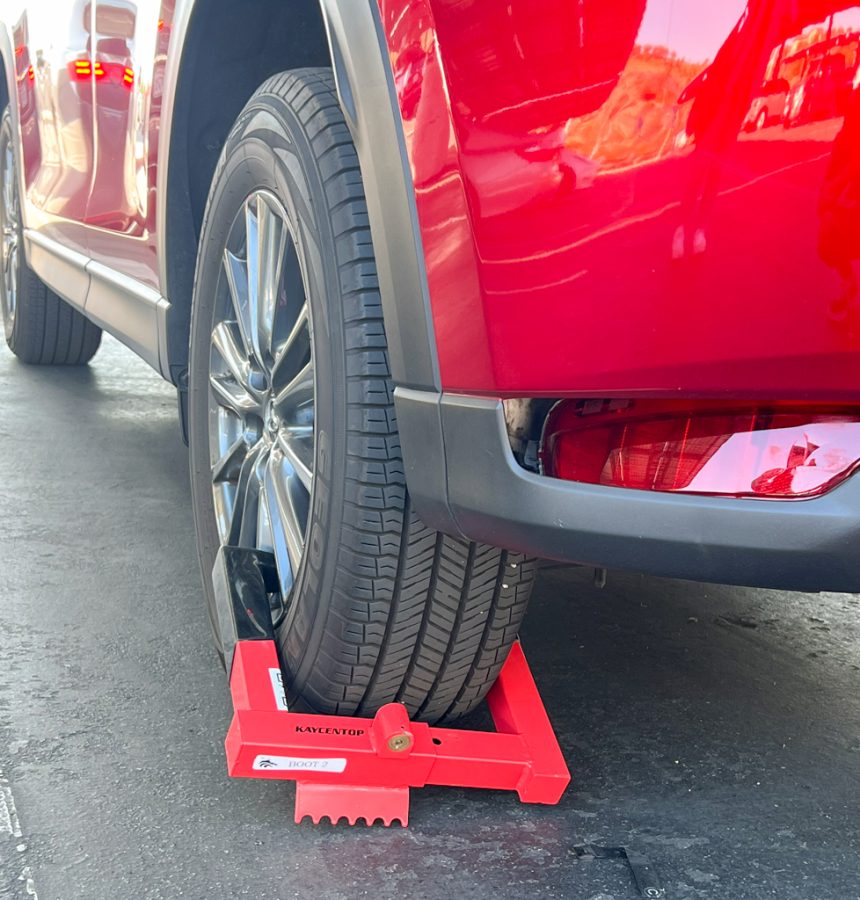Shifting Gears: Changes to the parking permit system
May 11, 2022
Looking out into the sea of cars that populate the NHS parking lot, the unmistakable identifiers of a parking violation – a pale yellow ticket slip pinned on a windshield, a neon yellow sign taped to the window and a bright paint-red boot on the wheel – seemingly mark a different car each day.
The amount and severity of parking violations, which most often occur when a student forgets to put up their paper parking permit on the dashboard, has not gone unnoticed by students. Northwood should switch back to sticker permits because they are a safer and more practical option.
Northwood made the switch to paper parking permits two years ago for a variety of reasons. Since stickers can only be attached to one car, students who drove secondary vehicles had to sign their car in with the front office each morning, and many forgot to do so, resulting in fines and car boots. Additionally, the sticker adhesive required stickers to be scraped off the windshield once the school year was over and the permit was no longer needed. Students often attempted to do so on their own, which could have resulted in windshield damage to the car.
To combat this, Northwood decided to implement paper parking permits, listing all registered car models, enabling students to transfer it between cars whenever necessary and theoretically this would result in fewer parking violations being issued, as students who drive multiple cars would not need to go through the process of registering the vehicle without the sticker every time they drove that car to school. While the number of parking violations have decreased (although it may not seem like it to many students), this cannot be attributed solely to the change in the system from sticker to paper permits. The system to check in secondary vehicles has changed as well, permitting students to simply email the ASB student banker before coming to school or seeing her immediately once they park in order to clear their vehicle and avoid a violation. This system is much quicker and easier for students, and as such is easier for students to avoid violations at all.
The problem with the paper permit is the paper itself creates an unsafe driving condition. If kept on the dashboard while driving, the permit often slides around while accelerating, braking and turning, even slipping off the dashboard. Not only does the movement become distracting, but students are inclined to reach for the moving permit, creating a distracted driver situation. The half-sheet of paper is a bright color (this year, a neon lime green) with a metallic sticker in the middle, both of which reflect onto the windshield noticeably, particularly when it is taped down. The movement and reflection are distracting enough for drivers in general, but arguably more so for teenage drivers, who are more inexperienced and prone to accidents than their adult counterparts. A sticker would minimize both distractions – nothing would be sliding around on the dashboard, and the reflection would be minimal, if at all noticeable.
To counteract the distractions, many students remove the permit from their dashboard after they leave campus and put it back when they park each morning. However, this step is easily forgotten in the rush of getting to school on time, leading to parking violations, fines and boots.
This system was implemented to reduce the number of parking violations that students received when they forgot to check-in a secondary vehicle (a vehicle without a sticker permit) to the front office. However, the change in the number of violations has also been altered by the change in the system of checking in those secondary vehicles, which eliminates one of the biggest inconveniences of the sticker system.
Another downfall of the sticker system that can be eliminated is the removal of the sticker from the windshield. Students can easily get the stickers removed quickly and professionally at a local car shop or car wash, as the process itself can be done cleanly in under ten minutes. If the sticker system is brought back, the school should be able to communicate this information with students so they are aware that there are professional options to the sticker removal. Additionally, since there are many students who hold parking permits, the school could potentially coordinate with local car shops to offer this service to students at a discounted price.
The two main problems with the sticker system are easily solvable. However, the paper system has problems that cannot be easily solved. It is distracting because of both its bright color and movement on the dashboard while the vehicle is in motion, and as such is dangerous. Having students take it down while driving and put it back up every time they park at school is impractical because students are (and have been) more likely to forget to do so, and suffer more punishment for simple mistakes. The sticker system is more efficient and practical, and should be brought back for the safety and benefit of the student body.



![AAAAAND ANOTHER THING: [CENSORED] [REDACTED] [BABY SCREAMING] [SIRENS] [SILENCE].](https://thehowleronline.org/wp-content/uploads/2025/06/lucy-1200x800.jpg)


















































![AAAAAND ANOTHER THING: [CENSORED] [REDACTED] [BABY SCREAMING] [SIRENS] [SILENCE].](https://thehowleronline.org/wp-content/uploads/2025/06/lucy-300x200.jpg)




Licole Nurtis
May 18, 2022 at 2:04 pm
Yes!!
Lian Riu
May 18, 2022 at 2:05 pm
Noo!!